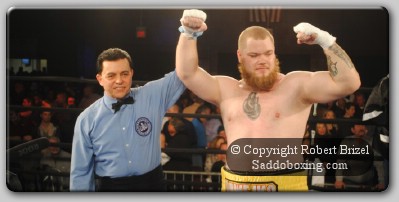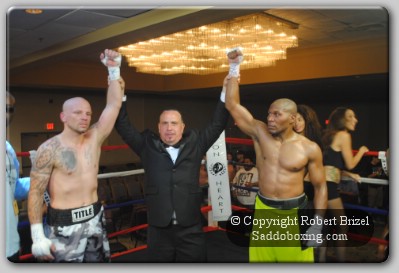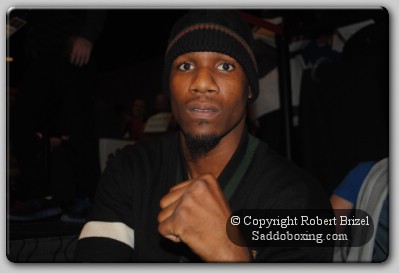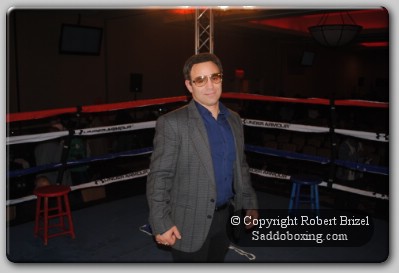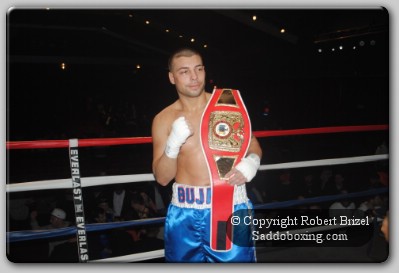Part two: Where The Modern Era Meets The Old School
Saddoboxing: How are Monty Meza Clay and Verquan Kimbrough doing?
Tom Yankello: They’re doing good. In fact, we’re going to have a card at The Mountaineer with both of them. It’s going to be on ESPN2 on August 11. Edner Cherry is going to be the headliner. Monty is going to be the co-feature. Verquan will be the swing bout. Brian will be fighting in an off TV six rounder.
SB: What weight is Verquan going to fight at? I know there’s been a lot of discussion about him moving up in weight.
TY: He’s going to fight at 135 pounds. He was having a horrible time making 126, and even 130. He was a National Champion in 2001 and 2002 at 132 pounds when he was 18-19 years old. He’s 23 years old, and growing into being a man. He was fighting at too light a weight. He might even end up fighting above 135 pounds. It was a big mistake on everyone’s part involved in trying to have him fight at 126 pounds.
SB: Although you’re a relatively young trainer at 35, you study a lot of film of the old-time fighters. You’ve actually been around the sport a long time as well. Who are some of your favorite fighters of previous eras? What are some of the technical things they did in the ring that impressed you, and how do you pass that on to your fighters?
TY: I love the old-time guys. I think they were the most technically sound boxers. I think today’s guys are better athletes, but I think the guys from the 1960s and back all the way to the turn of the century were the real pioneers of the game, and the real technical fighters who had so much craft.
There’s a lot of guys I really like. I loved Ezzard Charles. Guys like Archie Moore, Jersey Joe Walcott, Willie Pep, Henry Armstrong, Sugar Ray Robinson. I just think those guys were great, great fighters. So much technique, defense, and craft. They knew how to move around the ring and punch from every angle. They know how to block every punch in the book, and come back with a counter shot for every shot they block or slip. Old-time guys like that are amazing.
I thought Robinson was the greatest ever, but I think the guys I mentioned are almost as good. Guys like Ezzard Charles as a light heavyweight and then a heavyweight champion. Archie Moore had over 200 fights and around 140 knockouts. I don’t care who you are fighting, when you’re knocking out that many guys, it’s a special thing that doesn’t come from just punching power. It comes from accuracy and hitting guys off of defense, and hitting guys with punches they don’t see.
SB: He was incredibly crafty.
TY: Yes he was. In passing and teaching the skills of the old-time fighters to my fighters, I think you have to have the ability to adjust each fighter and see what their styles are. Every one of my guys will watch different guys.
For example, I wouldn’t have a Monty Meza Clay watch Sugar Ray Robinson. I’d have him watch Henry Armstrong. I put Monty on a lot of Armstrong fights. I’d also have him watch Archie Moore because of how Moore rolls with punches coming forward or backward.
With Verquan Kimbrough, I’d have him watch a boxer-puncher like Sugar Ray Robinson.
Sugar Ray Leonard was not an old-time fighter, but he was awesome. I love watching Roberto Duran. Duran was a great fighter. I let Brian Minto watch everyone. In his division, he’s going to have to do everything from the outside and the inside.
I watch a lot of Joe Louis with Calvin.
SB: Louis was a study in technical precision. The way in which Joe Louis distributed his weight behind short punches with the hip rotation was just incredible.
TY: Right….exactly.
SB: In terms of fighters today, I think you identified the crux of the matter perfectly. You have better athletes, but most don’t have the real technical skills of fighters of the past because of activity levels and things they picked up on from old school trainers.
On that note, can you name a few fighters of today that do possess those technical skills? I’m pretty sure I know your first answer.
TY: Two come to mind. The first is James Toney.
SB: Right. That’s the one.
TY: The other is Bernard Hopkins. I think Bernard does a lot of crafty things. There’s a lot of fights where Bernard is roughhousing and some of his fights look ugly, but he’s very crafty.
If I had to pick one, it would be Toney. He’s a perfect example of what I’ve been talking about. Athletes versus true craftsman. He would not have been able to do what he’s done from middleweight all the way up to heavyweight being fat and out of shape unless he was a true, skilled technician with those old school skills. He looks out of shape and he looks like you could do anything with him, but he’s just so crafty and so smart in there. He’s the guy.
Honestly speaking, a lot of people say he’s an overachiever, but he’s actually an underachiever.
SB: That is true in a certain sense.
TY: If he would’ve been in shape all along, imagine what he would’ve done.
SB: Exactly.
TY: When he stopped Holyfield, he was 217, and I even thought he was too heavy for that fight. Granted, Holyfield was on his way out, but imagine what Toney would’ve done with Rahman and those other guys if he were close to his weight for Holyfield? He would’ve handled Rahman, and he would’ve dominated Ruiz even easier. He’s just that good.
Going from a craft standpoint, and even from what’s he’s done, I truly believe he might be one of the top 10 greatest fighters that ever lived.
SB: To watch him think his way through fights, with all of the amazing technical things he does, and how old school tough he is, it really represents a true educational refresher course for any fighter who is coming up through the ranks.
TY: Right.
SB: You work with amateur and professional fighters. I personally don’t like amateur scoring, and I think it makes it harder on a fighter to transition from the amateur ranks to the pro ranks. What training and technical adjustments do you teach to fighters who are transitioning from the amateur ranks to the professional ranks?
TY: Oh, it’s purely and completely different. The amateurs have become an outside, head hunting game. The headshots are the ones that are seen most by the computer, and it’s really a joke. You have to stay in the middle of the ring, so that all 5 judges can see the punches land a lot easier, and you can get scores a lot easier that way.
When you turn a kid pro, the pace is a lot different. You’ve got to learn how to fight on the inside. You have to learn a lot more craft on the inside. You have to go to the body. In the amateurs, they’re almost purely going to the head because those are the only punches that are really getting scored by the computer.
There’s only one plus that I’ve heard as an argument from other coaches about the amateurs. A lot of these kids are becoming accurate “head killers.” They’ve become real accurate sharp shooters to the head because they’ve been so focused on being able to do that because they’ve had to do that if they’re able to score in the amateurs.
Still, it does take them away from the true art of the game. It takes them away from the pace of the pro game. Lack of defense, no inside fighting and body shots, so you have to teach a kid how to change pace, how to pick his shots, how to be better defensively on the inside. Really concentrate on how to go to the body because they don’t learn that at all in the amateurs anymore because it really doesn’t get scored and it’s neglected.
When you turn pro, you really have to become a much better defensive fighter because you have to defend your body and your head, and the gloves are smaller and you no longer have headgear. The shots are more solid, more potent, and more direct.
If I’m taking a fighter from the amateurs to the pros, I really focus and teach him on how to close up his defense and go to the body. You have to learn how to stand your ground on the inside, and quit trying to make distance and just score points from the outside. You must learn how to close the distance.
SB: You have your own training facility outside of Pittsburgh in Ambridge. You also use Buzz Garnic’s training facility about 40 miles south of Pittsburgh near California, Pennsylvania. Give us some background information on your facility, Buzz Garnic’s facility and your relationship with him, and educate us on the decision making process on why you use one facility as opposed to another in preparation for certain fights?
TY: Well, I first started boxing and I got injured. My career was cut short because I had four shoulder surgeries. I had a friend of mine who wanted to start a gym. We started the gym in Aliquippa in 1992.
Even before that, we had a guy named Mark Panzanetta who started a gym in Ambridge in 1991. I was in Aliquippa from 1992-1995, and he ran this gym here in Ambridge for about four years, and he did a helluva job. He did some amateur shows, and things like that.
What I had in Aliquippa was basically a basement of a youth center and a church. The facility was not that big, whereas the facility in Ambridge is big. They used to hold banquets there. It’s a nice big floor. Boxing wasn’t Mark’s main focus. He works at the medical center, and then he opened up an old age home.
He called me up one day, and asked me to consider taking over the lease. Before that, back in 1991, the ceiling was leaking and floors were busted. He fixed all of that up. He put some nice bags up, and got a halfway decent ring.
Later on, I got in and really did it up and it continued to progress. He was too busy with his other jobs, but he wanted to keep the gym open. I thought about his offer, and I decided to do it and moved the operation back to Ambridge. I’ve been there for the last 11 years.
Some problems started when I was training Paul, and then when Calvin Brock started training here in Ambridge as well. Ambridge is a small suburb about 14 miles northwest of downtown Pittsburgh. It was hard to train these guys and have them driving here to the gym.
When Calvin would come, it took 25 minutes one way to get here. Sometimes I would go down there in the morning and run him, or he would come up here. If traffic was bad, it could take 40 minutes.
What I discovered is that when I took Paul to camp before the Cardona fight, I knew from that experience how beneficial a camp atmosphere could be. You’re right there. You’re always eating, sleeping, and drinking boxing. Everything is on time. You’re running on time, you’re resting on time, you’re eating on time, you’re doing everything on time. No driving back and forth and lag time. Everything is focused towards you performing at your best at all times.
At the end of 2004, Buzz actually contacted me. He had started building the camp in 2003 when Paul fought Dorin. That’s the last time I went to camp with Paul, and that’s where we went. It was half finished at that time, but it worked. We stayed there at his house because the living quarters in the camp weren’t done yet.
In 2004, it was done. He called me, and wanted me to use it. He goes back a long way. He was involved with Don Turner and was involved with a lot of fighters like Darrin Van Horn, and a bunch of other fighters.
That original camp had burned down in 1989. The camp had started around 1986, and then it caught fire. I can’t remember the details of how it actually caught fire. For all of those years, he didn’t have a camp, and then he wanted to do it again.
I took Calvin down to see it, and Calvin really liked it and wanted to train there. He didn’t like driving back and forth like he did up in the Pittsburgh area, and he wanted to transition to the California camp about several weeks before a fight.
So, for example, right now I’m in Ambridge. When Calvin goes into training, we’ll actually open camp 7-8 weeks before his fight, and train solely at the California camp.
With my other guys, I’ll train them in Ambridge somewhat, and I have some other coaches who work with the amateurs. Monty, Brian, and Verquan are training in Ambridge now, but with the card coming up on August 11, we’ll move down to the California camp next week for extra focus. That’s how everything has worked. They can train well in Ambridge, but actually do it better at Buzz’s camp.
SB: One of the issues in boxing is that a lot of people think the “old professors” are mostly gone. Over the past century, Eddie Futch, Charley Goldman, Jack Blackburn, Ray Arcel, Freddie Brown, Sam Solomon, and Jackie McCoy are some of the all-time great trainers who made a permanent mark in the sport, but most feel we don’t have a depth of trainers like that today.
Georgie Benton stopped training fighters a long time ago. Lou Duva and Angelo Dundee are now in their 80s, and are moderately active in the sport. Gil Clancy is also in his 80s and is retired. Bouie Fisher now appears to be retired.
In terms of active trainers, Emanuel Steward changed his business model years ago, and has done well with it. Kenny Weldon persevered for years as an excellent trainer, and just guided Sergei Liakhovich to a heavyweight belt. Young trainers like Buddy McGirt & Freddie Roach have emerged as the big name trainers in the sport.
You’re one of the up and coming young trainers in the sport. Steward, McGirt, and Roach have gyms, but do a lot of freelance or consulting-style work. Conversely, you seem to run a traditional stable of fighters, and you’re rooted in southwestern Pennsylvania. What are your short-term and long-term goals as a trainer? Do you foresee operating like McGirt and Roach, or do you see a different path?
TY: Good question. I truly believe I’ll get the opportunity to work with other high profile guys. I’ve proven what I can do with talent. I’ve developed some home grown talent, and sometimes that’s the hard road to go.
I’ve heard some things through the grapevine that certain fighters want me to train them, but it’s hard. Believe it or not, some fighters just like to train where it’s warm. Vero Beach….you’re obviously going to go down there and like it. You go out to Los Angeles with Freddie Roach, and you love it. It’s the same thing with Joe Goosen.
If you really look at it, in my opinion the trainers are in Florida, Las Vegas, and California. They’re in the warm climates. I know we have New York and other East Coast trainers, but the only guy to be successful outside of that to a large degree is Emanuel Steward.
At the same time, I think the last time Steward trained Klitschko, they trained in California. They went to the warm climate. He trains some fighters at Kronk, but a lot of times, he has his apprentices and assistants run it. He pays them a certain amount, and he works with the elite fighters in camp.
For my future, as I expand and from a business standpoint, I’ve always thought about opening up a camp in Florida. I would have someone run this gym in Ambridge. My brother helps here, too.
I can see maybe 5 years down the line as I expand, have the camp with Buzzy here in California, Pennsylvania and starting up a camp in Florida. Maybe do half a year up here and half a year down there: April to October up here, and October to March down there. Those are thoughts that have run through my mind to make it more appealing for some fighters.
SB: Even though you’re only 35, you’ve been around the sport for a long time. What are some of the good things about being a trainer, and what are some of the things you could do without?
TY: Obviously, I really like working with the fighters and developing a relationship with them. I like seeing the work that you put into them come out in the ring. That’s what makes the world go around.
Some of the bad things are just not being appreciated. You put a lot of heart and soul into it, and sometimes your compensation can be a problem. Sometimes you can have a financial argument with someone who you think you shouldn’t have a financial argument with. You work with them all of that time, and they end up making a lot of money, and you helped build that, and you don’t make much more than before.
Human nature is amazing sometimes. In the beginning, there are no disputes and it’s about the love of the game, the heart and fun of it, and the dreams of making big money. Then, when the big money comes, even though you must respect that they’re the ones in the ring taking the punches, they sometimes end up thinking they can do it themselves.
In other words, when you work with a fighter from the ground up, the job actually gets easier because you’ve built an elite fighter. You’ve built the house and the foundation, and then in the end you’re just trimming the bushes. It’s funny because you’re making more money trimming the bushes than when you were building the house. If you look at it properly, though, you are getting paid for building the house because you weren’t being paid in the beginning when you were building the house. A lot of times they forget you helped build the house, and they want to pay you for just trimming the bushes. That’s the best way I could put it.
SB: (Laughing) That’s actually an extremely good way of putting it. It also sort of applies to situations that we see in boxing where a fighter has been built over time, and then Emanuel Steward takes over. Emanuel does some adjustments, and straightens out some kinks. Sometimes it can even be psychological. They end up making a lot of money, and Emanuel makes his money.
Having said that, to draw a parallel, Emanuel started out the old fashioned way. I call it “the smokestack” way. Kronk was a factory. He brought in raw material. He manufactured it. He streamlined it, and then he had a finished product. He did it in Detroit right where cars are manufactured.
Now, we’re in a different age. We’re deindustrialized. We don’t have a lot of manufacturing in the inner cities as it applies to both creating boxing talent and in the world of business as well. The inner cities, especially in the more traditional “smokestack” cities like Detroit, are smaller and lesser amounts of raw material are coming through fewer gyms.
Since 1980, the City of Detroit has lost over 300,000 residents. Emanuel doesn’t have as much raw material coming through Kronk, he’s adjusted his business model, and he now does some finishing work as a consultant with fewer home grown fighters in his gym. It’s the same thing that you refer to as “trimming the bushes”, but he takes on projects with elite fighters after the initial work was done with different trainers.
He earned it, though. He started out young like you. He didn’t have it completely easy. He made a name for himself. He had some talented fighters at Kronk over the years, and he developed them. He reaped the benefits through hard work. Hopefully, you’ll be able to do the same. That’s the way it works.
TY: Exactly. The biggest thing I don’t like about the game is the human nature of a handshake. It’s not good in the game.
SB: Yes. It’s also become worse over the last few decades.
TY: Right. I’ve made a lot deals with my fighters over the years with a handshake. As time has gone on, sometimes the handshake seems like a weak handshake. It seems like the deal has been manipulated. It hurts. Sometimes the attitude is “What have you done for me lately?” My response is “Look what I’ve done for you all along and didn’t get paid for it?”
Everyone in boxing knows that you don’t make much money on the way up. Money is made with the elite fighters. It’s not like professional football or professional basketball where you sit on the bench and make a lot of money.
If you’re not a champion or a top contender, you’re not making much at all. A lot of times you’re actually investing money and spending money to work with fighters. Then, when the house is built and you haven’t been paid, they forget that you’ve built the house when the bushes were being trimmed. That’s the worst part.
The best thing is when you see the hard work in the gym pay off. To see the progress and sometimes you have beautiful and honorable relationships with your fighters. I’ve had them. That’s what makes the world go around.
SB: Thanks for your time, and your thoughtful answers.
TY: No problem, Greg.
 Boxing News Boxing News
Boxing News Boxing News
